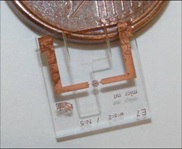
NMR analysis of mass-limited samples remains a major challenge, which has triggered the development of expensive superconducting ultra-high field magnets, as well as of more expensive and technologically demanding solutions as cryoprobes and hyperpolarization schemes. Mass-limited samples could also benefit from the use of miniaturized coils, since the amplitude of the NMR signal is optimal when the sizes of the coil and sample match.
In our group, we work on the design and fabrication of NMR-chips, rf-planar microcoil integrated on top of a glass substrate, and the construction of a small-volume NMR probe in which an optimized position for the NMR-chip allows the analysis of mass- and volume limited samples for different applications.
In parallel, we are also focused on the integration of an NMR chip with microreactors by developing continuous-flow hyphenated systems of different activation sources with nanoliter NMR spectroscopy. Alternative modes of activation, such as microwave irradiation and light-emitting diodes (LED) are employed. In this sense, a microwave-assisted continuous-flow microreactor was hyphenated with nanoliter-volume NMR spectroscopy, providing a rapid optimization of reaction conditions with low cost and reduced amount of solvents. The main advantage of the systems deals with the fact of allowing the division of the reaction volume -usually higher than the detection volume- into several zones -each of these ones exposed to the activation source for different times when working under flow conditions- and the analysis of each zone separately. Therefore, choosing the appropriate flow rate, experimental variables and NMR acquisition parameters, the necessary data points for optimizing the reaction conditions can be obtained in a single constant-flow experiment. This advantage is of highly importance specially when dealing with microwave as energy source where in most cases, the time required for analysis is longer than the reaction itself.